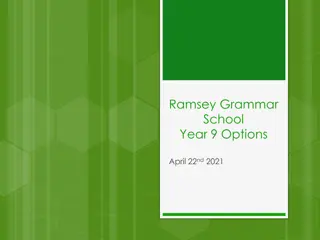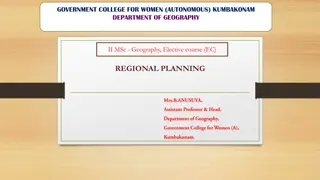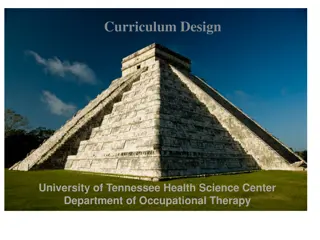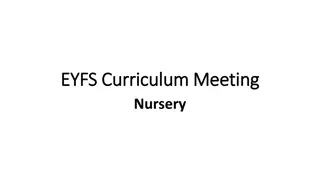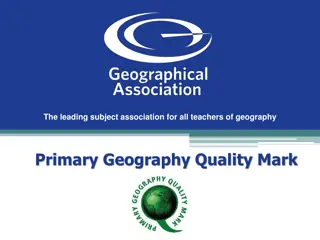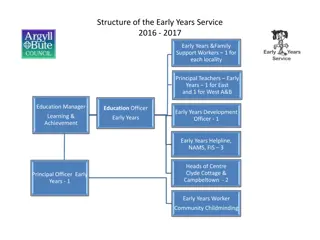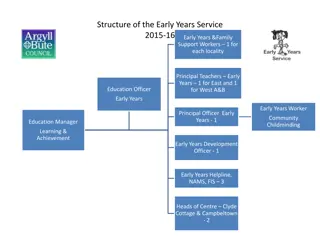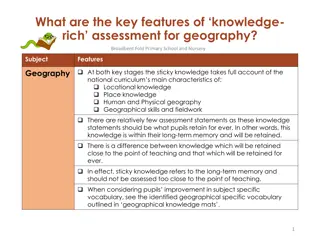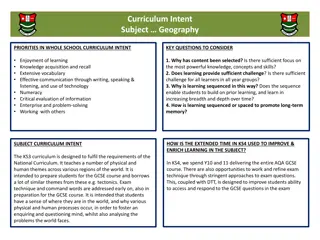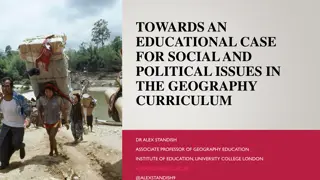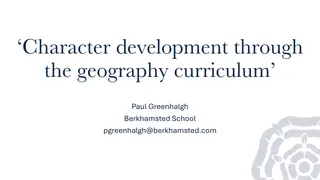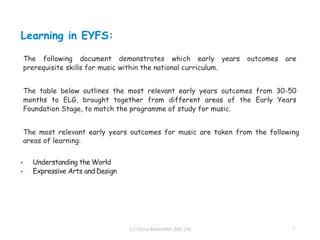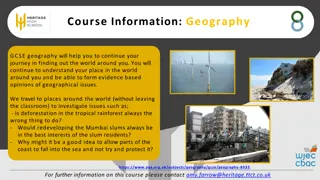Early Years Outcomes Prerequisite Skills for Geography in National Curriculum
The document outlines early years outcomes crucial for geography in the national curriculum, spanning from 30-50 months to ELG. It highlights skills like observing, questioning, understanding growth, showing care, recognizing similarities and differences, and more in young learners, preparing them for later geography studies. The key stage 1 geography curriculum requirements include locational knowledge, place knowledge, human and physical geography, and geographical skills and fieldwork, emphasizing understanding global and local environments, weather patterns, geographic features, and the use of maps.
Download Presentation

Please find below an Image/Link to download the presentation.
The content on the website is provided AS IS for your information and personal use only. It may not be sold, licensed, or shared on other websites without obtaining consent from the author.If you encounter any issues during the download, it is possible that the publisher has removed the file from their server.
You are allowed to download the files provided on this website for personal or commercial use, subject to the condition that they are used lawfully. All files are the property of their respective owners.
The content on the website is provided AS IS for your information and personal use only. It may not be sold, licensed, or shared on other websites without obtaining consent from the author.
E N D
Presentation Transcript
Learning in EYFS: The following document demonstrates which early years outcomes are prerequisite skills for geography within the national curriculum. The table below outlines the most relevant early years outcomes from 30-50 months to ELG, brought together from different areas of the Early Years Foundation Stage, to match the programme of study for geography. The most relevant early years outcomes for geography are taken from the following areas of learning: Understanding the World (c) Focus Education (UK) Ltd 1
Geography 30-50 Months Understandin g the World The World To comment and ask questions about aspects of their familiar world, such as the place where they live or the natural world. To talk about some of the things they have observed, such as plants, animals, natural and found objects. To talk about why things happen and how things work. To develop an understanding of growth, decay and changes over time. To show care and concern for living things and the environment. To look closely at similarities, differences, patterns and change. 40-60 Months Understandin g the World The World ELG Understandin g the World People and Communities To talk about past and present events in their own lives and in the lives of family members. To know about similarities and differences between themselves and others, and among families, communities and traditions. The World To know about similarities and differences in relation to places, objects, materials and living things. They talk about the features of their own immediate environment and how environments might vary from one another. (c) Focus Education (UK) Ltd 2
What the national curriculum requires in geography at key stage 1 Locational knowledge Name and locate the world s seven continents and five oceans Name, locate and identify characteristics of the four countries and capital cities of the United Kingdom and its surrounding seas Locational knowledge Place knowledge Understand geographical similarities and differences through studying the human and physical geography of a small area of the United Kingdom, and of a small area in a contrasting non-European country Place knowledge Human and physical geography Identify seasonal and daily weather patterns in the United Kingdom and the location of hot and cold areas of the world in relation to the Equator and the North and South Poles Use basic geographical vocabulary to refer to: o Key physical features, including: beach, cliff, coast, forest, hill, mountain, sea, ocean, river, soil, valley, vegetation, season and weather o Key human features, including: city, town, village, factory, farm, house, office, port, harbour and shop Human & physical geography Geographical skills and fieldwork Use world maps, atlases and globes to identify the United Kingdom and its countries, as well as the countries, continents and oceans studied at this key stage Use simple compass directions (North, South, East and West) and locational and directional language [for example, near and far; left and right], to describe the location of features and routes on a map Use aerial photographs and plan perspectives to recognise landmarks and basic human and physical features; devise a simple map; and use and construct basic symbols in a key Use simple fieldwork and observational skills to study the geography of their school and its grounds and the key human and physical features of its surrounding environment. Geographical skills & fieldwork 3
What the national curriculum requires in geography at key stage 2 Locational knowledge Locate the world s countries, using maps to focus on Europe (including the location of Russia) and North and South America, concentrating on their environmental regions, key physical and human characteristics, countries, and major cities Name and locate counties and cities of the United Kingdom, geographical regions and their identifying human and physical characteristics, key topographical features (including hills, mountains, coasts and rivers), and land- use patterns; and understand how some of these aspects have changed over time Identify the position and significance of latitude, longitude, Equator, Northern Hemisphere, Southern Hemisphere, the Tropics of Cancer and Capricorn, Arctic and Antarctic Circle, the Prime/Greenwich Meridian and time zones (including day and night) Locational knowledge Place knowledge Understand geographical similarities and differences through the study of human and physical geography of a region of the United Kingdom, a region in a European country, and a region within North or South America Place knowledge Human and physical geography Describe and understand key aspects of: o Physical geography, including: climate zones, biomes and vegetation belts, rivers, mountains, volcanoes and earthquakes, and the water cycle o Human geography, including: types of settlement and land use, economic activity including trade links, and the distribution of natural resources including energy, food, minerals and water Human & physical geography Geographical skills and fieldwork Use maps, atlases, globes and digital/computer mapping to locate countries and describe features studied Use the eight points of a compass, four and six-figure grid references, symbols and key (including the use of Ordnance Survey maps) to build their knowledge of the United Kingdom and the wider world Use fieldwork to observe, measure, record and present the human and physical features in the local area using a range of methods, including sketch maps, plans and graphs, and digital technologies. Geographical skills & fieldwork 4
Knowledge, Skills and Understanding breakdown for Geography Year 1 Geographical knowledge Can they identify the four countries making up the United Kingdom? Can they name some of the main towns and cities in the United Kingdom? Can they point out where the equator, north pole and south pole are on a globe or atlas? Geographical enquiry Physical geography Human geography Can they say what they like about their locality? Can they sort things they like and don t like? Can they answer some questions using different resources, such as books, the internet and atlases? Can they think of a few good questions to ask about a locality? Can they answer questions about the weather? Can they keep a weather chart? Can they tell someone their address? Can they explain the main features of a hot and cold place? Can they describe a locality using words and pictures? Can they explain how the weather changes with each season? Can they name key features associated with a town or village, e.g. church, farm, shop, house? Can they begin to explain why they would wear different clothes at different times of the year? Can they say something about the people who live in hot and cold places? Can they explain what they might wear if they lived in a very hot or a very cold place? Year 1 (Challenging) Can they answer questions using a weather chart? Can they make plausible predictions about what the weather may be like later in the day or tomorrow? Can they name key features associated with a town or village, e.g. factory, detached house, semi- detached house, terrace house? Can they name different jobs that people living in their area might do? Can they name a few towns in the south and north of the UK? (c) Focus Education (UK) Ltd 5
Knowledge, Skills and Understanding breakdown for Geography Year 2 Geographical knowledge Can they name the continents of the world and find them in an atlas? Can they name the world s oceans and find them in an atlas? Can they name the main cities of England, Wales, Scotland and Ireland? Can you find where they live on a map of the UK? Geographical enquiry Physical geography Human geography Can they label a diagram or photograph using some geographical words? Can they find out about a locality by using different sources of evidence? Can they find out about a locality by asking some good questions to someone else? Can they say what they like and don t like about their locality and another locality like the seaside? Can they describe some physical features of their own locality? Can they explain what makes a locality special? Can they describe some places which are not near the school? Can they describe a place outside Europe using geographical words? Can they describe some of the features associated with an island? Can they describe the key features of a place, using words like, beach, coast forest, hill, mountain, ocean, valley? Can they describe human features of own locality, such as the jobs people do? Can they explain how the jobs people do may be different in different parts of the world? Do they think that people ever spoil the area? How? Do they think that people try to make the area better? How? Can they explain what facilities a town or village might need? Year 2 (Challenging) Can they make inferences by looking at a weather chart? Can they make plausible predictions about what the weather may be like in different parts of the world? Can they find the longest and shortest route using a map? Can they use a map, photographs, film or plan to describe a contrasting locality outside Europe? Can they explain how the weather affects different people? Can they locate some of the world s major rivers and mountain ranges? Can they point out the North, South, East and West associated with maps and compass? (c) Focus Education (UK) Ltd 6
Knowledge, Skills and Understanding breakdown for Geography Year 3 Geographical knowledge Can they name a number of countries in the Northern Hemisphere? Can they locate and name some of the world s most famous volcanoes? Can they name and locate some well-known European countries? Can they name and locate the capital cities of neighbouring European countries? Are they aware of different weather in different parts of the world, especially Europe? Geographical enquiry Physical geography Human geography Do they use correct geographical words to describe a place and the things that happen there? Can they identify key features of a locality by using a map? Can they begin to use a 4 figure grid reference? Can they accurately plot NSEW on a map? Can they use some basic OS map symbols? Can they make accurate measurements of distances within 100Km? Can they use maps and atlases appropriately by using contents and indexes? Can they describe how volcanoes are created? Can they describe how earthquakes are created? Can they confidently describe physical features in a locality? Can they locate the Mediterranean and explain why it is a popular holiday destination? Can they recognise the 8 points of the compass (N,NW, W, S, SW, SE, E, NE)? Can they describe how volcanoes have an impact on people s life? Can they confidently describe human features in a locality? Can they explain why a locality has certain human features? Can they explain why a place is like it is? Can they explain how the lives of people living in the Mediterranean would be different from their own? Year 3 (Challenging) Can they work out how long it would take to get to a given destination taking account of the mode of transport? Can they explain why a locality has certain physical features? Can they explain how people s lives vary due to weather? Can they name the two largest seas around Europe? (c) Focus Education (UK) Ltd 7
Knowledge, Skills and Understanding breakdown for Geography Year 4 Geographical knowledge Can they locate the Tropic of Cancer and the Tropic of Capricorn? Do they know the difference between the British Isles, Great Britain and UK? Do they know the countries that make up the European Union? Can they name up to six cities in the UK and locate them on a map? Can they locate and name some of main islands that surround the UK? Can they name the areas of origin of the main ethnic groups in the UK & in their school? Geographical enquiry Physical geography Human geography Can they carry out a survey to discover features of cities and villages? Can they find the same place on a globe and in an atlas? Can they label the same features on an aerial photograph as on a map? Can they plan a journey to a place in England? Can they accurately measure and collect information, e.g. rainfall, temperature, wind speed, noise levels etc.? Can they describe the main features of a well-known city? Can they describe the main features of a village? Can they describe the main physical differences between cities and villages? Can they use appropriate symbols to represent different physical features on a map? Can they explain why people are attracted to live in cities? Can they explain why people may choose to live in a village rather than a city? Can they explain how a locality has changed over time with reference to human features? Can they find different views about an environmental issue? What is their view? Can they suggest different ways that a locality could be changed and improved? Year 4 (Challenging) Can they give accurate measurements between 2 given places within the UK? Can they explain how a locality has changed over time with reference to physical features? Can they explain how people are trying to manage their environment? Can they name the counties that make up the home counties of England? Can they name some of the main towns and cities in Yorkshire and Lancashire? (c) Focus Education (UK) Ltd 8
Knowledge, Skills and Understanding breakdown for Geography Year 5 Geographical knowledge Can they name and locate many of the world s major rivers on maps? Can they name and locate many of the world s most famous mountain regions on maps? Can they locate the USA and Canada on a world map and atlas? Can they locate and name the main countries in South America on a world map and atlas? Geographical enquiry Physical geography Human geography Can they collect information about a place and use it in a report? Can they map land use? Can they find possible answers to their own geographical questions? Can they make detailed sketches and plans; improving their accuracy later? Can they plan a journey to a place in another part of the world, taking account of distance and time? Can they explain why many cities of the world are situated by rivers? Can they explain how a location fits into its wider geographical location; with reference to physical features? Can they explain how the water cycle works? Can they explain why water is such a valuable commodity? Can they explain why people are attracted to live by rivers? Can they explain how a location fits into its wider geographical location; with reference to human and economical features? Can they explain what a place might be like in the future, taking account of issues impacting on human features? Year 5 (Challenging) Can they work out an accurate itinerary detailing a journey to another part of the world? Can they explain what a place (open to environmental and physical change) might be like in the future taking account of physical features? Can they report on ways in which humans have both improved and damaged the environment? Can they begin to recognise the climate of a given country according to its location on the map? (c) Focus Education (UK) Ltd 9
Knowledge, Skills and Understanding breakdown for Geography Year 6 Geographical knowledge Can they recognise key symbols used on ordnance survey maps? Can they name the largest desert in the world? Can they identify and name the Tropics of Cancer and Capricorn as well as the Artic and Antarctic circles? Can they explain how time zones work? Geographical enquiry Physical geography Human geography Can they confidently explain scale and use maps with a range of scales? Can they choose the best way to collect information needed and decide the most appropriate units of measure? Can they make careful measurements and use the data? Can they use OS maps to answer questions? Can they use maps, aerial photos, plans and web resources to describe what a locality might be like? Can they give extended description of the physical features of different places around the world? Can they describe how some places are similar and others are different in relation to their human features? Can they accurately use a 4 figure grid reference? Can they create sketch maps when carrying out a field study? Can they give an extended description of the human features of different places around the world? Can they map land use with their own criteria? Can they describe how some places are similar and others are different in relation to their physical features? Year 6 (Challenging) Can they define geographical questions to guide their research? Can they use a range of self selected resources to answer questions? Can they plan a journey to another part of the world which takes account of time zones? Do they understand the term sustainable development? Can they use it in different contexts? Can they explain how human activity has caused an environment to change? Can they analyse population data on two settlements and report on findings and questions raised? Can they name and locate the main canals that link different continents? Can they name the main lines of latitude and meridian of longitude? (c) Focus Education (UK) Ltd 10








